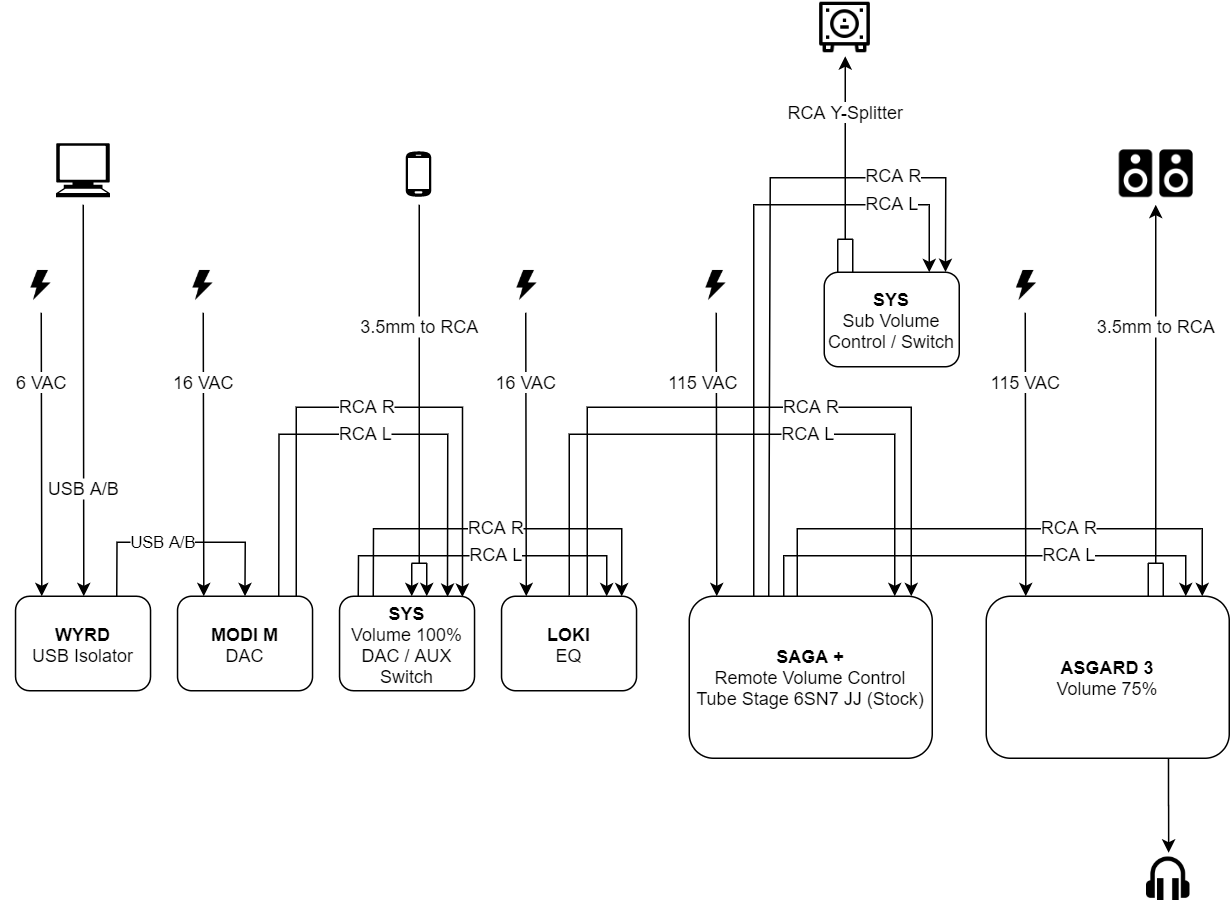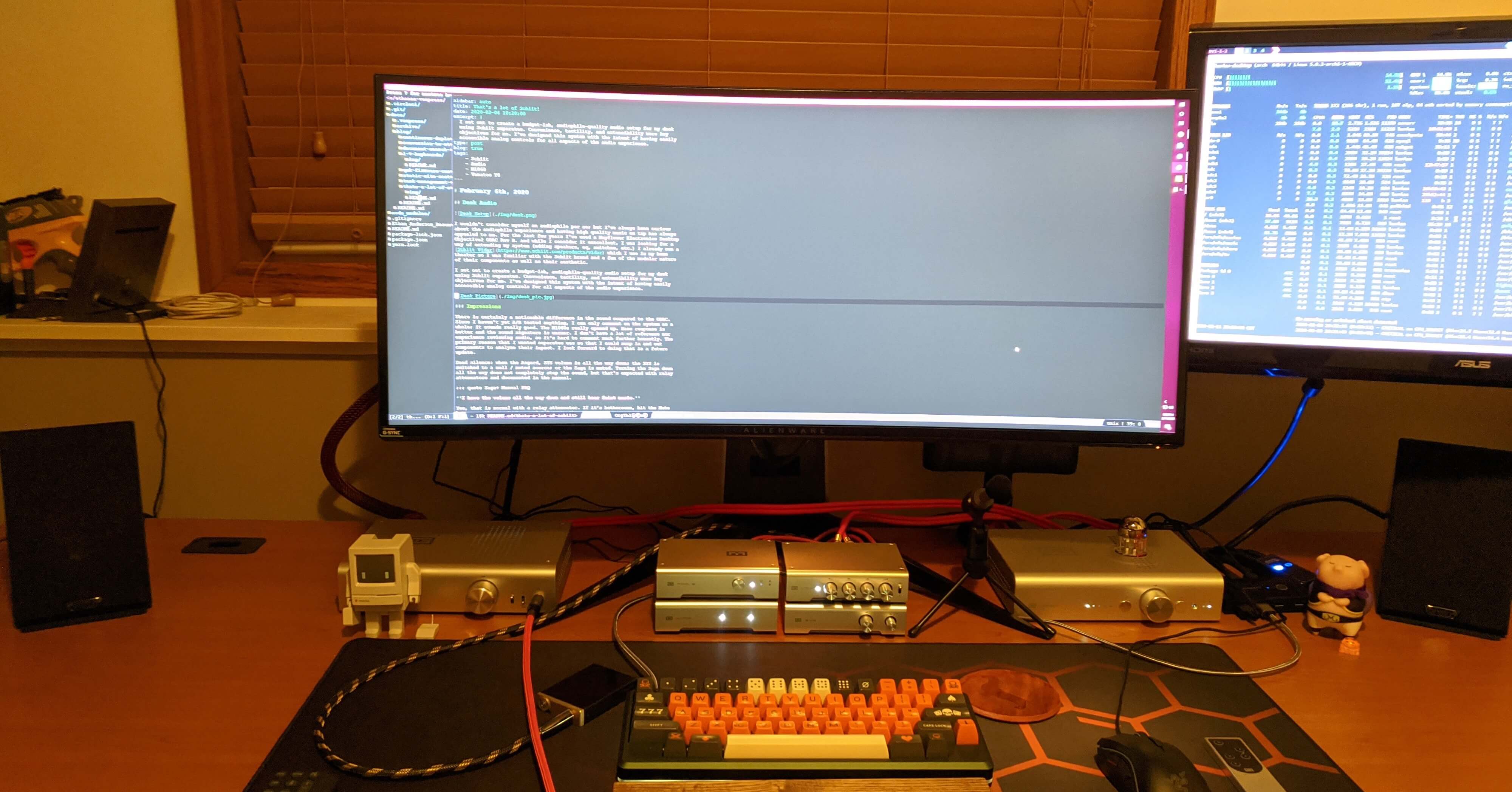# February 6th, 2020
# Desk Audio

I wouldn't consider myself an audiophile per se; but I've always been curious about the audiophile experience and having high quality music on tap has always appealed to me. For the last few years I've used a Mayflower Electronics Desktop Objective2 ODAC Rev B. and while I consider it execellent, I was looking for a way of extending my system (adding speakers, eq, switches, etc.) I already own a Schiit Vidar which I use in my home theater so I was familiar with the Schiit brand and a fan of the modular nature of their components as well as their aesthetic.
I set out to create a budget-ish, audiophile-quality audio setup for my desk using Schiit separates. Convenience, tactility, and extensibility were key objectives for me. I've designed this system with the intent of having easily accessible analog controls for all aspects of the audio experience.

# Impressions
There is certainly a noticeable difference in the sound compared to the ODAC. Since I haven't yet A/B tested anything, I can only comment on the system as a whole; it sounds really good. The M1060s really opened up. Bass response is better and the sound signature is warmer. I don't have a lot of reference nor experience reviewing audio, so it's hard to comment much further honestly. The primary reason that I wanted separates was so that I could swap in and out components to analyze their impact. I look forward to doing that in a future update.
Dead silence: when the Asgard, SYS volume is all the way down; the SYS is switched to a null / muted source; or the Saga is muted. Turning the Saga down all the way does not completely stop the sound, but that's expected with relay attenuators and documented in the manual.
Saga+ Manual FAQ
I have the volume all the way down and still hear faint music.
Yes, that is normal with a relay attenuator. If it’s bothersome, hit the Mute button on the remote to completely mute the preamp.
From Saga+ Manual
# Audio Player
I'm using Windows 10 with foobar2000 and the WASAPI output support component. Currently running the default theme, but interested in trying out DarkOne4Mod or some other nice looking skins.
# Components
# WYRD
Cures USB Dropouts, Noise, and Other Problems
Wyrd isolates USB-input DACs from power supply noise from computer USB sources, eliminating strange noises, dropouts, and power management problems with USB audio interfaces.
Schiit has measured USB power supply noise up to 400mV p-p on computer USB outputs. Wyrd replaces this “dirty” power with clean power from a linear supply with ultra-low-noise (2.5uV) voltage regulators—more than 100,000x less than what comes out of some USB ports. It also repeats the USB signal with a low-jitter, 20ppm crystal oscillator, with its own local low-noise power supply for higher performance.
“Some of our early listeners also claim that Wyrd improves sonic performance, as well,” Jason continued. “But we’re not going to say this. Bottom line, it’s a great way to solve some irritating USB audio interface problems. That’s it.”
Review and Measurements of Schiit WYRD USB Filter
I got the Wyrd for Christmas and was running it for over a year with my ODAC. I A/B tested it (not blind) and could not tell a difference. I leave it in the chain because it may prompt skeptics to listen more critically (and hear more detail that's not necessarily attributable to the Wyrd itself 😉).
# MODI Multibit
The Most Affordable Advanced Multibit DAC—From Anyone, Anywhere
“Modi Multibit smashes the price barrier in advanced multibit DACs,” said Mike Moffat, Schiit’s Co-Founder and head of digital development. “It is the most affordable multibit DAC built on a modern architecture—from any manufacturer, in any country in the world.”
Modi Multibit is built on Schiit’s proprietary multibit DAC architecture, featuring Schiit’s unique closed-form digital filter on an Analog Devices SHARC DSP processor. For D/A conversion, it uses a medical/military grade, true multibit converter specified down to 1/2LSB linearity, the Analog Devices AD5547CRUZ.
Multibit DACs differ from the vast majority of DACs in that they use true 16-20 bit D/A converters that can reproduce the exact level of every digital audio sample. Most DACs use inexpensive delta-sigma technology with a bit depth of only 1-5 bits to approximate the level of every digital audio sample, based on the values of the samples that precede and follow it.
# Compared to Modi 3
Schiit Modi 3 vs. Modi Multibit – A Schiit Shootout!
The Multibit barely squeaks out with a win, but apparently it's not easy to tell the difference between the two. Some have said that the Modi 3 is flat and one-dimensional by comparison.
Review: Battle of Schiit Audio DACs
Looking at objective measurements, it appears that the Multibit produces a considerably less faithful analog output of the digital samples its fed when compared to the delta-sigma Modi 3. Multiple people have referred to this analagously as tubes versus solid state, with the "tube" sound coming from the Multibit.
# SYS
Volume Control and 2-Input Switch
SYS stands for "switch your, er...schtuff." Sys is a simple, 2-input passive preamp. No electronics. No power. No distortion. Just a 2-way switch and a potentiometer.
From SYS Product Page
Review and Measurements of Schiit Sys Passive Pre-amp/Switcher
The test results show flat, transparent performance so long as you're not using a volume below 50% on the SYS and your non-selected input is muted.
I'm using the SYS to switch between inputs. With the satisfying press of a button I can switch between my computer (Modi) and an AUX input (phone, DAP, etc.). I've connected it upstream of everything besides the DAC so that all benefits of the system (currently just Loki) are available to either source.
# LOKI
Schiit Introduces Affordable, Discrete, LC-Filtered Hardware EQ for $149
Unlike old-school EQs of the 1980s, which and frequently had problems with noise from stacks of op-amp gain stages and open-frame slider controls, Loki Mini is designed for superior sound. A single, fully-discrete gain stage and a single discrete buffer per channel is coupled with sealed Alps potentiometers, a 100% linear power supply with +/-18V rails, and LC (inductor-capacitor) filtering to keep performance high and noise low.
Loki Mini also features gentle control and rational ranges to allow for precise and subtle tonal alterations. Potentiometers are progressive, so that a full 30 degrees is needed for the first dB of boost or cut. Loki Mini offers adjustment center frequencies of 20 Hz, 400 Hz, 2kHz, and 8kHz. 20Hz and 8kHz offer +/-12dB of adjustment, while 400Hz and 2kHz offer +/-6dB.
Loki Mini also offers a true bypass switch—one that simply connects the input to the output, with no intervening circuitry. The front-mounted switch allows users to compare the processed output to the “flat” output instantaneously.
The Loki makes a 100% noticable impact on the sound, but it's an EQ; so it's supposed to do that. You'd be expected to get cleaner results using software EQ, but I really like the fact that this one is analog (and simple to use). Right now I use it primarily as an easy-to-toggle bass boost for low listening volumes (20 Hz and 400 Hz at 2 o' clock).
# SAGA+
Schiit Announces Four Preamps—and a New Sales Approach
Single ended passive or tube hybrid buffer remote controlled preamp with 64-step relay stepped attenuator. Saga+ is an enhancement of the original Saga, with a motorized potentiometer to track the remote control and DC heaters for even lower noise. Like all Sagas and Freyas, it also features a relay-stepped attenuator for volume control.
From PREAMP THUNDERDOME
A Four-Way Schiit Shootout – Freya S/+ Vs. Saga S/+
The Saga+ has an advertised output impedance of 180 ohms when running the hybrid tube buffer stage. The Asgard 3 that I'm using has an input impedance of 22k ohms which should satisfy the 10:1 (load:source) rule...
Review and Measurements of Schiit Saga Tube Pre-amp
"Looking all the way to the right, the minimum impedance is 183 ohm. At the lower end of 20 Hz, impedance climbs to 3,130 ohm. Using the typical 10:1 rule, your power amplifier input impedance should be at least 30k ohm to avoid frequency dependent/EQ changes. Put more simply, if you use lower input impedance power amplifier after Saga in active mode, your low frequencies below 500 Hz or so will attenuate. This may accentuate the rest of the spectrum you may like, or not."
In active mode, low frequncies seem to drive the output impedance up considerably; which puts my Asgard 3 a bit out of the recommended 30k ohm input impedance range, but luckily I have the Loki to help correct that should I notice it or just want to crank dat bass. 👍
Running in passive mode with the volume greater than 30% keeps the output impedance below 2k ohm and in the desired range for the Asgard.
On the Schiit specs page for the Saga+ it says:
I took that to mean that the output was switchable, but from the pictures and manual that's clearly not the case. I intended to use the Saga+ to switch between headphones and speakers, but now I'll likely use it to add a subwoofer with another SYS for volume control. I'd like to test using an inverted SYS to hopefully achieve the headphone / speaker toggle that I wanted out of the Saga+. Regardless, I think I'd need to add another SYS if I want to avoid having to unplug my headphones.
I love the remote and the motorized potentiometer: very satisfying and useful! It's really nice to be able to control the volume from the perfect listening spot.
# Hybrid Tube Buffer Stage vs Passive
Tube Rolling of Schiit Saga Pre-amplifier
I'm running the stock 6SN7 JJ New Production tube.
Swapping between the passive and active modes produces almost no difference to my ears. I think I prefer the active mode, it's almost unnoticeably louder (😆) and slightly warmer?
I'd like to try tube rolling (vintage?) to see if it changes the sound in a more noticeable way. Any recommendations are much appreciated.
# ASGARD 3
Schiit Reinvents the Two Products that Started it All
Asgard 3 moves from Class A to Schiit's proprietary Continuity™ output stage, shared with Lyr 3 and Aegir. Continuity extends the benefits of Class A outside of the Class A bias region, addressing the problem of transconductance droop identified by Bob Cordell and John Broskie. Asgard 3 runs 500mW of Class A bias, so it's running Class A for most headphone loads. However, when required, it can also deliver its full output of 3.5W RMS per channel into 32 ohms, both channels driven.
Schiit specifies a rating of 2.5W RMS per channel at 50 ohms - which is the impedance of my M1060s. I have the volume set at 75% and it produces a good listening volume on both my headphones and speakers with the Saga+ set somewhere between 40% - 70%.
I have my speakers connected to the Asgard's preout so that they are muted while I have headphones plugged in and resume playing when I unplug the headphones.
# Headphones / Speakers
# Monoprice M1060 v2
I really like the M1060, they were hyped heavily on release, and I think there was good reason for that (even if some issues / new releases have caused people to stop championing them). These were my first planars and my first headphones over $100. For me, coming from bad IEMs and gaming headsets, they were impressive. They have excellent soundstage and bass extension.
- Mods
- Dekoni Audeze LCD Elite Hybrid pads
- Removed outside foam
Many people have commented on the M1060 being inherently flawed due to them producing a noticeable 5k ring.
Max_Settings says...
Now we get to the sound. These headphones have one flaw that makes them unusable, at [sic] that is a 5K ring. I've tried to start this review many times, but every time I go to do my final listening they hurt so much after just a few minutes I get a headache. Every time I try them the same thing happens, major headache. For those of you who don't know what a ring is, a ring is when a certain frequency a headphone produces in majorly more pronounced than the others. This peak is like 15-20db greater than anything else which is massive. Some people can hear it and others can't. I can't particularly hear it, but man do I feel it, they are so fatiguing to listen to.
I cannot say that I hear it for sure (supposedly removing the foam behind the driver helps, maybe my pads help reduce it as well). I would agree that M1060 can be fatiguing when listening for extended periods or at high volumes, but they've never given me a headache after a few minutes.
They do suffer from build quality issues though; the wood ring on my right ear cup cracked within the first month, but it's a small crack and not worsening. It doesn't seem to affect the sound or the structural integrity of the headphones.
The next addition to the system (once I've saved back up some pennies) will likely be another pair of headphones. I'm thinking about the Focal Elex, Audeze LCD-2, the HIFIMAN Arya, or one of the ZMF Dynamics. I'm not sure if I'd prefer a better planar or to have a nice set of dynamics to contrast with the M1060s.
# Vanatoo Transparent Zero
Very clear with great imaging. For relatively small speakers, they vibrate my desk with their bass. Oh, and you can connect them to pretty much anything.
Vanatoo Transparent Zero Review
All of the reviews that I've seen are positive. At this price point, for small desk speakers; there appears to be little competition.
Looking forward to taking some measurements with REW and my UMIK-1 to get them dialed in 100%.
# Cables
# Schiit PYST RCA
Super solid cables. I wish they sold longer lengths than 6 inches.
# Seismic Audio RCA
Premium, but affordable cables available on Amazon. Good build quality and really flexible, although the connectors can be a bit tight. Red like the PYST! Sadly not the same shade.
# SKW 3.5mm to RCA
Feels high quality; a little stiff. Also on Amazon.
# WAudio Power Cable
These are some really thicc bois. I'm running two 3.3 ft ones to power the Saga+ and the Asgard.
# Periapt TYPE 2 - DUAL 2.5MM
Really nice headphone cable. Should last a lifetime.
# Power Conditioner
The Furman PST-8 Power Station seems to do the trick. I've only ever owned surge protectors before, never a power conditioner.
I got this to A/B against basic power strips and because I did encounter ground-loop hum when setting up my Vidar in my home theater. I solved it with the recommended Ebtech Hum X, but I'm still not sure how that device works (if it's truly not a ground lift as advertised).
With the Furman I can't hear any noise; so while I'm not yet sure if it helps, it doesn't hurt.
